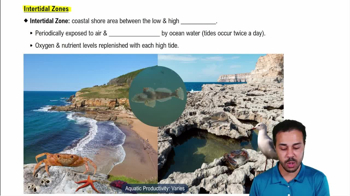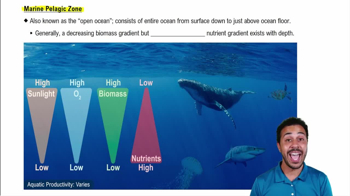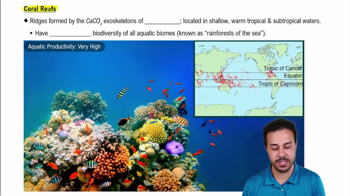Marine Aquatic Biomes exam Flashcards
 Back
BackMarine Aquatic Biomes exam
1/28
Terms in this set (28)
- Intertidal ZoneThe coastal shore area between high and low tides, experiencing exposure and submersion twice daily.
- What adaptations do organisms in the intertidal zone have?They have evolved to survive fluctuating conditions of exposure to air and submersion by ocean water.
- Marine Pelagic ZoneAlso known as the open ocean, it covers three-quarters of Earth's surface and includes the entire ocean from the surface to just above the ocean floor.
- How does sunlight affect the marine pelagic zone?Sunlight decreases with depth, leading to varying productivity in different layers of the ocean.
- Coral ReefsBiodiversity hotspots formed by calcium carbonate exoskeletons of coral polyps, found in warm, shallow waters.
- Why are coral reefs known as the rainforests of the sea?Because they have the highest biodiversity of all aquatic biomes.
- Marine Benthic ZoneThe ocean floor, nutrient-rich due to decomposing biomass, supporting unique ecosystems.
- What is the marine snow effect?The process where decomposing dead organisms, or detritus, fall to the sea floor, enriching the benthic zone with nutrients.
- What are hydrothermal vents?Deep-sea features that provide a unique source of chemical energy, supporting specialized organisms in the marine benthic zone.
- How often do tides occur in the intertidal zone?About twice in a period of 24 hours.
- What is the primary production limitation in the deep marine benthic zone?Limited sunlight prevents photosynthesis, restricting primary production.
- What is the significance of calcium carbonate in coral reefs?It forms the sturdy exoskeletons of coral polyps, creating the complex structure of coral reefs.
- What factors influence productivity in the marine pelagic zone?Sunlight and nutrient gradients.
- What is the role of detritus in the marine benthic zone?Decomposing dead organisms enrich the benthic zone with nutrients.
- What are the conditions required for coral reefs to thrive?Warm, shallow waters with specific environmental conditions.
- What is the oxygen gradient in the marine pelagic zone?Oxygen levels decrease with depth.
- What is the biomass gradient in the marine pelagic zone?Biomass decreases with depth.
- What is the nutrient gradient in the marine pelagic zone?Nutrient levels increase with depth.
- What are tidal pools?Pools of water in the intertidal zone that can host specific species of fish and other organisms.
- How does the intertidal zone replenish oxygen and nutrients?High tides submerge the zone, moving water around and redistributing oxygen and nutrients.
- What is the significance of the marine pelagic zone's size?It is the largest biome on Earth, covering about three-quarters of the Earth's surface.
- What are coral polyps?Aquatic animals that secrete calcium carbonate to form coral reefs.
- What is the primary source of nutrients in the marine benthic zone?Decomposing biomass from more productive surface waters.
- What is the impact of sunlight on the marine benthic zone?Most of the benthic zone receives little to no sunlight, limiting photosynthesis.
- What is the role of hydrothermal vents in the marine benthic zone?They provide chemical energy for specialized organisms, supporting unique ecosystems.
- What is the relationship between depth and nutrient levels in the marine pelagic zone?Nutrient levels increase with depth due to sinking decomposing matter.
- What are the two main types of intertidal zones?Sandy beaches and rocky shores.
- What is the significance of the marine benthic zone's nutrient richness?It supports diverse and unique ecosystems, including those near hydrothermal vents.



